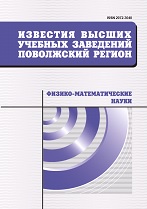|
Physics
The features of recombination radiation in quantum dots with an (A$^{+}$ + e) impurity complex in an external electric field. Part 1. Effect of an external electric field on the binding energy of a hole in an (A$^{+}$ + e) impurity complex in a spherically symmetric quantum dot
A. V. Levashov, V. D. Krevchik, M. B. Semenov, A. V. Razumov
Penza State University, Penza, Russia
Abstract:
Background. Recently, there has been growing interest in studying the influence of electric field effects on the properties of semiconductor quantum dots. This is due to the fact that in such systems there is a high degree of freedom in controlling the band structure and binding energy of impurity states, which is important from the point of view of instrumental applications. Of particular interest is the study of the effect of an electric field on impurity $A^{+}$ states, which are capable of forming long-lived $(A^{+}+e)$ complexes with nonequilibrium electrons. Varying the strength of the external electric field opens up possibilities for controlling the binding energy of the $A^{+}$ state, the concentration of charge carriers, and also the optical properties of quasi-zero-dimensional structures. The purpose of this work is to theoretically study the effect of an external electric field on the binding energy of a hole in an $(A^{+}+e)$ impurity complex in a spherically symmetric quantum dot (QD). Materials and methods. The interaction between an electron in the ground state of a quantum dot and a hole localized at the $A^{+}$ center is considered within the framework of the adiabatic approximation. The dispersion equation that determines the dependence of the hole binding energy in the $(A^{+}+e)$ impurity complex in a spherically symmetric quantum dot on the magnitude of the external electric field was obtained within the framework of the zero radius potential model, in the effective mass approximation. All curves are plotted for quantum dots based on InSb. Results. An analytical solution of the problem of bound states of a hole in the $(A^{+}+e)$ omplex in a spherically symmetric quantum dot in the presence of an external electric field is obtained in the zero-radius potential model in the adiabatic approximation. The cases of centered and non-centered location of the $A^{+}$ center in a quantum dot are considered. It is shown that the field dependence curve of the binding energy of the $A^{+}$ center has a characteristic maximum, the position of which is related to the dynamics of the adiabatic potential in an external electric field. It is shown that there is a threshold value of the external electric field strength at which the existence of a bound $A^{+}$ state becomes impossible. Conclusions. The monotonic behavior of the dependence of the binding energy of the $A^{+}$ state on the QD radius is broken if the $A^{+}$ center is not centered. For certain values of the QD radius, the binding energy reaches its maximum value, which is associated with the coincidence of the position of the $A^{+}$ center and the minimum of the adiabatic potential.
Keywords:
quantum dot, impurity complex, zero radius potential method, adiabatic approximation, external electric field.
Citation:
A. V. Levashov, V. D. Krevchik, M. B. Semenov, A. V. Razumov, “The features of recombination radiation in quantum dots with an (A$^{+}$ + e) impurity complex in an external electric field. Part 1. Effect of an external electric field on the binding energy of a hole in an (A$^{+}$ + e) impurity complex in a spherically symmetric quantum dot”, University proceedings. Volga region. Physical and mathematical sciences, 2022, no. 1, 66–82
Linking options:
https://www.mathnet.ru/eng/ivpnz7 https://www.mathnet.ru/eng/ivpnz/y2022/i1/p66
|

|




 Contact us:
Contact us: Terms of Use
Terms of Use
 Registration to the website
Registration to the website Logotypes
Logotypes








 Citation in format
Citation in format 